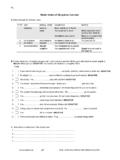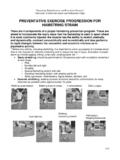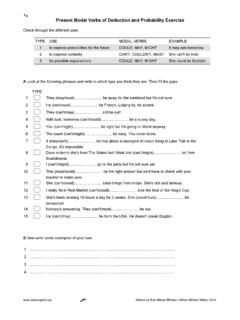Transcription of Using a hands-on exercise to teach cost accounting concepts
1 Journal of Business Cases and Applications Using a hands-on exercise Using a hands-on exercise to teach cost accounting concepts Barbara Vinciguerra Moravian College C. Andrew Lafond The College of New Jersey The accounting Education Change Commission has emphasized the need for students to be active participants in the learning process. This paper describes an active- learning exercise that provides a familiar and fun setting to serve as a backdrop for explaining basic cost accounting concepts . The exercise simulates a manufacturing process where two products are produced by teams of students. Student teams then identify costs, classify costs and experience the process of determining product cost . First, students cost products Using a method used by the company. Later, students are challenged to develop a better method for determining product costs. Finally, students must advocate for the most appropriate method to be used.
2 This exercise is a useful contribution to an introductory cost or management accounting course because it provides a clear, simple manufacturing and costing process Using readily available office materials to complete the exercise . It also provides a common learning experience on which to base future discussions of budgeting and variance analysis. Keywords: product costing, job order costing, introduction to managerial accountingJournal of Business Cases and Applications Using a hands-on exercise INTRODUCTION Many students perceive cost accounting topics to be difficult to comprehend (Lightbody, 1995, Haskins and Crum, 1985). This is due, in part, to the fact that most students have not worked in a manufacturing environment and have difficulty relating to textbook manufacturing-centered examples and problems. In 1990, the accounting Education Change Commission (AECC) stated that Students must be active participants in the learning process, not passive recipients of by doing should be emphasized (AECC, 1990, p.)
3 307). accounting educators have addressed this issue through the creation of active-based learning exercises (Burns and Mills, 1997; Lightbody, 1997). This paper describes a hands-on learning exercise Using a simplistic manufacturing process that can easily be implemented in a traditional classroom. The exercise is designed as an aid to teaching basic product cost concepts by illustrating the concepts of cost classification, the assignment of overhead costs, and the calculation of product cost for inventory purposes Using job order costing. Engaging students in the manufacturing process allows students to develop a deeper understanding of the various cost elements as well as an opportunity to self-discover the complexities of cost allocation. In addition, the exercise allows for a common class experience to serve as a backdrop for other management accounting issues including process costing, budgeting and variance analysis.
4 Previous papers have provided factory simulations to address cost accounting issues. Burns and Mills (1997) used Legos to illustrate product costing, accounting for materials, labor, and overhead, creating job cost sheets and building work-in-process inventory. Lightbody (1997) introduced a factory simulation exercise by having students produce paper rabbits and calculate work in process and finished goods inventory values. The benefit of the exercise described in this paper is that it is much simpler than the Burns and Mills (1997) exercise , allowing students to cost a product from beginning to end Using relatively little classroom time and with little to no special investment in materials on the part of the instructor. In addition, our exercise provides more complexity than the Lightbody (1997) exercise , which allows the instructor and students to explore a wider range of costing concepts and issues.
5 This active-learning exercise simulates a manufacturing facility where two products are manufactured by teams of students. These student teams are organized to simulate various duties in a manufacturing environment, classify costs, experience the process of overhead allocation, and subsequently determine the cost and target selling price per unit for each model. The students are provided with materials, assembly instructions, and some background cost information to develop cost per unit for each model. This exercise has been successfully used in undergraduate cost /managerial accounting classes. It can be completed in one or two classroom sessions and is an excellent tool in helping students understand the different product costs (direct materials, direct labor, and manufacturing overhead), calculating the cost of a product, and the challenge in assigning overhead to a product.
6 LEARNING OBJECTIVES The specific learning objectives for the case are to develop students ability to: (1) Understand the various functions in a simple manufacturing environment. (2) Determine product cost in a job cost environment. Journal of Business Cases and Applications Using a hands-on exercise (3) Analyze the effectiveness of the current costing system. (4) Recommend an alternative to the current costing system. (5) Effectively communicate the results of the analysis in written form. CASE SCENARIO Company Background The Paper Products Factory (PPF) is a local manufacturer of a single product: paper party hats. They sell primarily to specialty stores in the Mid Atlantic region of the United States. There are several other national and international manufacturers of similar products; therefore it is a very competitive marketplace. The market is very price sensitive; small increases in price can result in large decreases in product demand.
7 The PPF is a family owned company that employs approximately 100 people. The owner and CEO of the company is Brian Clark. At this time no other family members are involved in the business. The company employs administrative staff including the president, vice presidents, and support staff; engineers who design and develop the products; sales representatives; manufacturing labor; distribution center employees; and customer service representatives. Patrick Clark, the owner s son, recently completed his Wanting to impress his father with his newly acquired skills, he presented his father with a business proposal to add a second product line - paper chains. Dad, by adding paper chains, we can expand our product line to our existing customer base. For the most part, our current sales and customer service structure can remain as is since we will be selling more products to our existing customers.
8 We would need to add an additional Production Manager to oversee the new product line. We have excess manufacturing capacity, skilled labor, and almost all of the manufacturing equipment necessary to make the chains. We can offer our hourly employees more steady work. The only additional costs will be the additional capital investment involved due to the purchase of some specialized cutting machines, which will cost $180,000 and can be expected to last about five years. We ll also have to lease a bit more space. Brian Clark though it over for a few days. Patrick, your proposal makes sense to me. By adding a product line, we should be able to decrease our unit product costs because our fixed costs will be spread over many more units. This should be good for the new chain product line and the hat product line. I can get additional manufacturing space by moving our administrative offices out of our manufacturing site and into an office complex nearby.
9 This will free up more space in the factory. I looked in to the purchase of the cutting machines and it seems that we will be able to finance the purchase at a low interest rate. There s only one more thing to consider. I will implement your idea only on the condition that you will join the company as the production manager for paper chains. Patrick agreed and is now the Paper Chain Production Manager reporting to the Director of Manufacturing. There are a variety of manufacturing departments that are involved in producing the products including: Warehouse, Materials Handling, Cutting, Assembly, Finishing, Quality Control, and Factory Supervisor. Supervision is provided throughout the process. Quality Control is provided at the end of the manufacturing process. A description of each department and a diagram of the factory floor is included in Figure 1 (Appendix) - Description of Manufacturing Departments Panel A and Panel B.
10 The PPF utilizes job order costing by assigning direct material, direct labor, and manufacturing overhead to each individual job. The costs are accumulated Using a Job cost Journal of Business Cases and Applications Using a hands-on exercise Sheet. See Figure 2 (Appendix) Blank Job cost Sheet. Given the simple, one-product nature of the manufacturing and cost environment in the past, they have always used the following method for determining job costs: (1) Direct material and direct labor are traced to each job based on time cards and materials requisition requests. (2) Manufacturing Overhead is applied Using the total actual manufacturing overhead cost for the month divided by the number of units produced in the month. The selling price of each job is determined Using a cost -plus pricing method. The final selling price is 115% of the cost determined on the job cost sheet.















